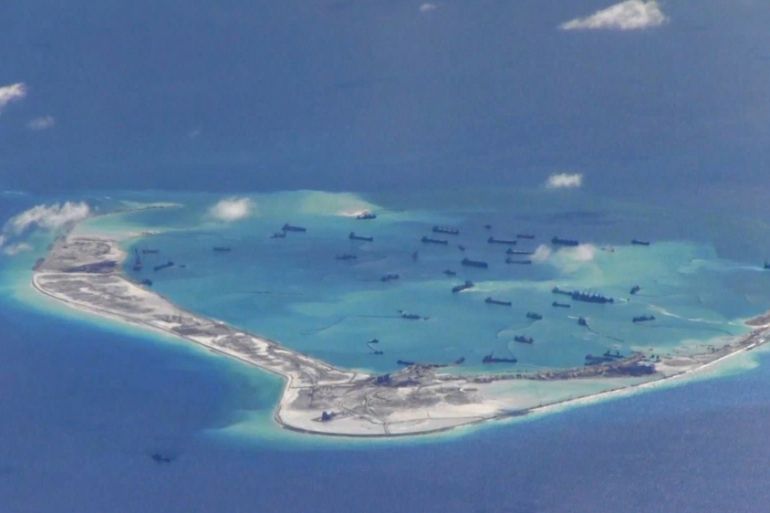PHL vs CHN: And then what?
Analysts divided over how the South China Sea dispute between the Philippines and China will progress.

The Philippines challenging China before an international tribunal over maritime disputes has been compared to David going after Goliath.
Many political analysts have questioned how wise a decision it is considering China’s sheer might in the international arena.
Keep reading
list of 4 itemsJapan, Philippines, US rebuke China over ‘dangerous’ South China Sea moves
Biden, Japan leader Kishida announce stronger defence ties in state visit
China’s Xi says outside interference can’t stop reunion with Taiwan
Not only is it the most populous country in the world, it is among the most powerful economies… with every other country tied to, if not dependent on, it for trade and development. How do you go up against a country like that?
People in Philippine diplomatic circles have said they’re not sure they can win the legal battle even if they feel the facts are on their side; they’re aware that there is so much more at play here.
|
|
Most importantly – what this will reveal about the strength of international law and adjudication.
The arbitration tribunal seems to be moving forward very delicately on the case, focusing first on China’s point of whether or not it even has jurisdiction to hear arguments over the dispute. (China says the Philippines wants a decision on sovereignty which the court has no jurisdiction over; the Philippines says it is only after the clarification of maritime entitlements and economic exploration rights – which is within the tribunal’s remit.)
Analysts say this shows that the judges have taken China’s position into account – even though China has officially made it clear that it is not “participating” in the case. It did however release a position paper on the South China Sea before the hearing got under way.
This was a clear strategic move, according to political analyst Chito Sta. Romana.
“The Chinese are basically the elephant in the room. They may not be there physically but their arguments [as laid out in the position paper] are the ones the Philippines has to refute beyond reasonable doubt,” Sta. Romana said.
“It is the art of not participating and yet influencing the opinion… or the verdict of the court, and the process of the arbitration.”
RELATED: Al Jazeera’s coverage of the South China Sea dispute
In a way, the Philippines has also taken its case to the court of public opinion.
Admitting they don’t think they stand a chance against China, some Philippine officials say they feel victorious enough simply filing the arbitration case.
“What this has done is put the issue, undeniably, on the international agenda,” one official told me.
“It’s on the table now, whereas it really wasn’t before… no matter how much we’d tried to bring it up.”
![Construction by China at Kagitingan Reef in the disputed Spratley Islands in the South China Sea [EPA]](/wp-content/uploads/2015/05/dc4b2a66b4dd44c2a1e5aef1e4fc8d78_18.jpeg)
In his opening statement before the tribunal at The Hague, the Philippine secretary of foreign affairs stressed that international law is meant to be “the great equaliser” of states.
But many wonder if, regardless of “law”, China hasn’t already got what it wants by default.
It has, after all, built islands – constructed land masses in disputed waters where there were none before.
Reportedly, these “islands” comprise some 810 hectares and include potential military installations and airstrips.
Sta. Romana says China “miscalculated” the United States’ response.
“The Americans saw it as the building of an unsinkable aircraft carrier in the middle of the South China Sea, so it has hit a nerve in the US,” he said.
|
|
“It has affected their strategic interest…intensifying the geo-political rivalry between the two on who will control the South China Sea… which the US has virtually controlled since the second world war.”
Now, China has established presence, allegedly in defiance of international law, hundreds of nautical miles from its coastline, simply because it can.
By doing so, it has caused hundreds of millions of dollars in damage – both environmental, and to the livelihood of nearby fishing communities.
China says it is well within its “historical rights” to do so, which begs the question: Does one historical perspective supersede another?
Is “history” beyond international law? What are the limitations? In all this, how far can the reach, and reaction, of the global community go? Analysts say all this is also on trial here.
The situation is not only at the forefront of regional security, it’s also at the crux of both the US and Russian “pivots” to the Asia-Pacific. Security analysts have called it potentially “the next flashpoint” for international relations.
So – noise made, attention secured – what next?
INTERACTIVE: Islands row around China
Even Filipino officials say they know the islands can’t be “undone”. And how would one even wrest control of them from a country such as China?
The regional giant has yet to alter its behaviour, despite the unfavourable global response to its island construction.
Sta. Romana points out that China cares about how it is perceived by the global community and is hopeful that this is would sway developments.
“It is not a forlorn case,” he said, referring to the Philippine argument before the tribunal.
“It won’t be easy… and it will take time… but it is not beyond hope.”
Not many in the region are as optimistic.